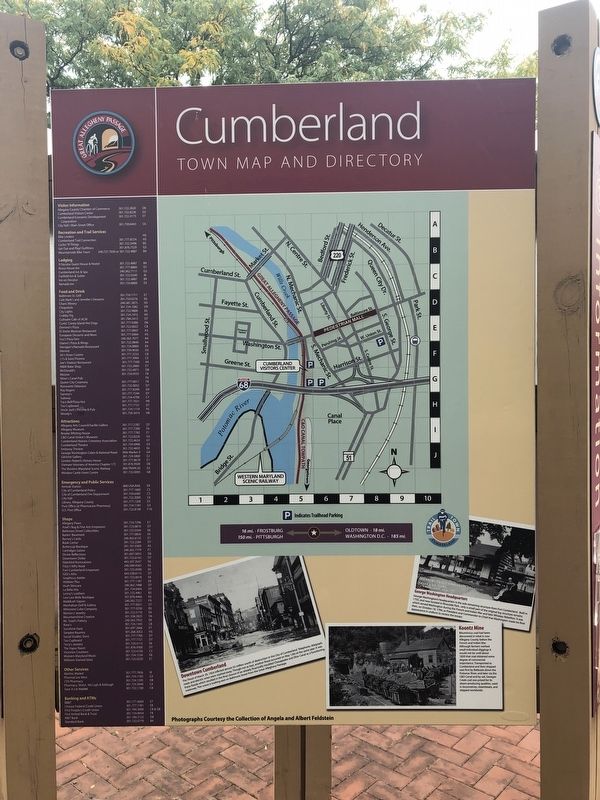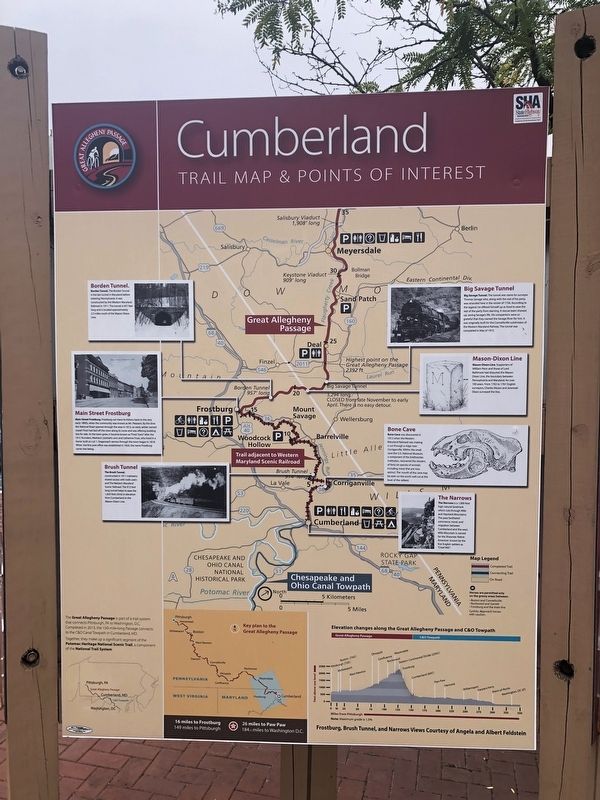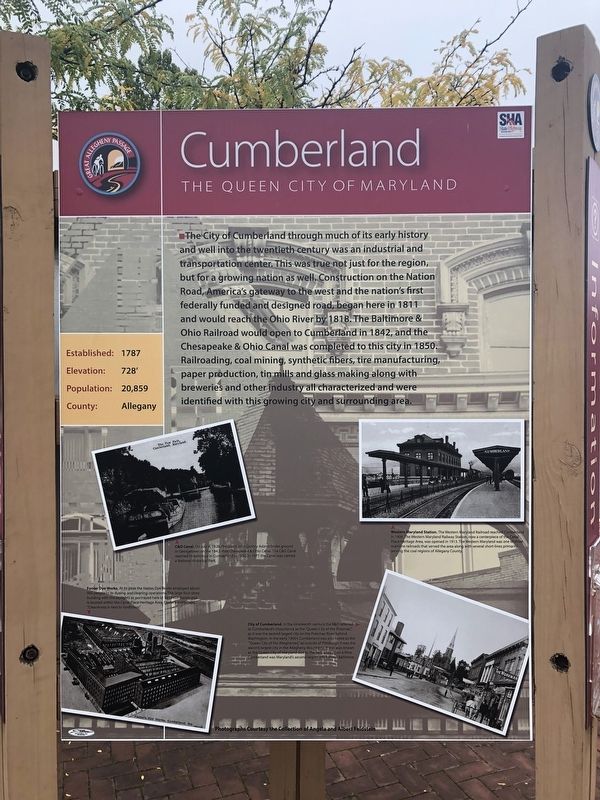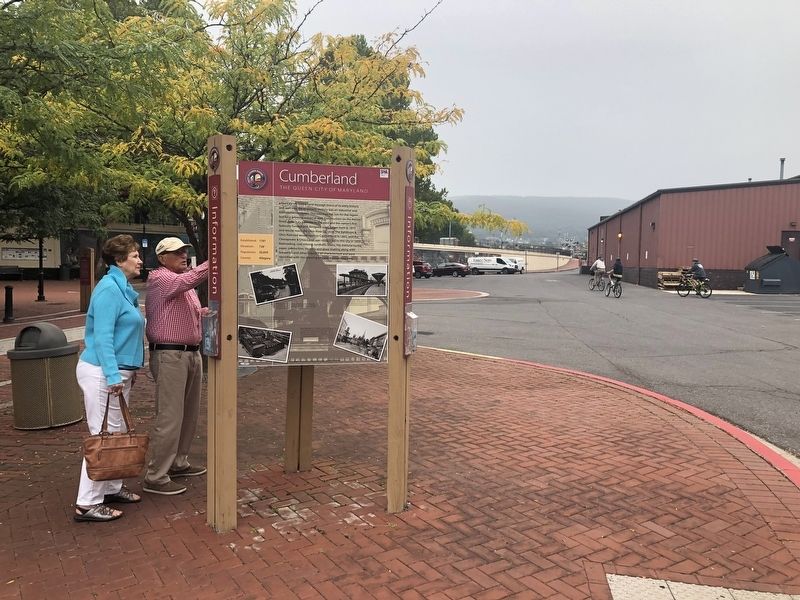Cumberland in Allegany County, Maryland — The American Northeast (Mid-Atlantic)
Cumberland
Town Map and Directory

Photographed By Devry Becker Jones (CC0), September 1, 2019
1. Cumberland, Town Map and Directory side of the marker
Downtown Cumberland
The Flood of March 29, 1924 inflicted almost $5 million worth of destruction in the City of Cumberland. Telephone, telegraph, roads and electric wires were washed away. Though not as bad, another flood occurred on May 12th of the same year. It was these floods which resulted in the final closure of an already financially troubled Chesapeake and Ohio Canal as a functioning waterway. This scene is looking east on Baltimore Street from the Great Allegheny Passage.
George Washington Headquarters
George Washington's Headquarters is the sole remaining structure from Fort Cumberland. Built in 1755, and now located in Riverside Park, only a small part of the original log structure remains which served Washington during the French and Indian War and later Whiskey Rebellion. It was then, on October 19, 1794, as President and Commander-in-Chief that Washington made his final appearance in uniform to review the troops.
Koontz Mine
Bituminous coal had been discovered in what is now Allegany County before the French and Indian War. Although farmers worked small individual diggings it would not be until about 1820 that coal obtained some degree of commercial importance. Transported to Cumberland and then shipped east first by flatboats down the Potomac River, and later via the C&O Canal and by rail, Georges Creek coal was prized for its steam-producing qualities, used in locomotives, steamboats, and shipped worldwide.
Trail Map & Points of Interest
Borden Tunnel.
Borden Tunnel. The Borden Tunnel is the last tunnel in Maryland before entering Pennsylvania. It was constructed by the Western Maryland Railroad in 1911. The tunnel is 957 feet long and is located approximately 2.5 mile south of the Mason-Dixon Line.
Main Street Frostburg
Main Street Frostburg. Frostburg can trace its history back to the very early 1800's, when the community was known as Mt. Pleasant. By the time the National Road opened through the area in 1812, an early settler named Josiah Frost had laid out the town along its route and was offering building lots for sale. As the town grew, it became known as "Frost Town" after the 1812 founders. Meshach (Josiah's son) and Catherine Frost, who lived in a home built on Lot 1, Stagecoach service through the town began in 1818. When the first post office was established in 1820, the name Frostburg came into being.
Brush Tunnel
The Brush Tunnel, constructed in 1911 maintains shared access with trail users and The Western Maryland Scenic Railroad. The 912 foot long tunnel helps

Photographed By Devry Becker Jones (CC0), September 1, 2019
2. Cumberland, Trail Map & Points of Interest side of the marker
Big Savage Tunnel
Big Savage Tunnel. The tunnel was named for surveyor Thomas Savage who, along with the rest of his party, was stranded here in the winter of 1736. According to the legend, he offered himself up as food to save the rest of the party from starving. A rescue team showed up, saving Savage's life. His companions were so grateful that hey named the Savage River for him. It was originally built for the Connellsville subdivision of the Western Maryland Railway. The tunnel was completed in May of 1912.
Mason-Dixon Line
Mason-Dixon Line. Supporters of William Penn and those of Lord Baltimore had disputed the Mason-Dixon Line, the boundary between Pennsylvania and Maryland, for over 100 years. From 1763 to 1767 English surveyors, Charles Mason and Jeremiah Dixon surveyed the line.
Bone Cave
Bone Cave was discovered in 1912 when the Western Maryland Railroad was making a cut through a ridge near Corriganville. Within the small cave the U.S. National Museum, a component of the Smithsonian Institution, recovered the remains of forty six species of animals including may that are now extinct. The mouth of the cave may be seen on the south wall cut at the level of the railbed.
The Narrows
The

Photographed By Devry Becker Jones (CC0), September 1, 2019
3. Cumberland, The Queen City of Maryland side of marker
The Great Allegheny Passage is part of a trail system that connects Pittsburgh, PA to Washington, D.C. Completed in 2013, the 150-mile-long Passage connects to the C&O Canal Towpath in Cumberland, MD.
Together, they make up a significant segment of the Potomac Heritage National Scenic Trail, a component of the National Trail System.
The Queen City of Maryland
The City of Cumberland through much of its early history and well into the twentieth century was an industrial and transportation center. This was true not just for the region, but for a growing nation as well. Construction on the National Road, America's gateway to the west and the nation's first federally funded and designed road, began here in 1811 and would reach the Ohio River by 1818. The Baltimore & Ohio Railroad would open to Cumberland in 1842, and the Chesapeake & Ohio Canal was completed to this city in 1850. Railroading, coal mining, synthetic fibers, tire manufacturing, paper production, tin mills and glass
[Aside:]
Established: 1787
Elevation: 728'
Population: 20,859
County: Allegany
[Captions:]
C&O Canal. On July 4, 1828, President John Quincy Adams broke ground in Georgetown on the 184.5 mile Chesapeake & Ohio Canal. The C&O Canal reached its terminus in Cumberland in 1850. In 1971, the Canal was named a National Historical Park.
Western Maryland Station. The Western Maryland Railroad reached Cumberland in 1906. The Western Maryland Railway Station, now a centerpiece of the Canal Place Heritage Area, was opened in 1913. The Western Maryland was one of three mainline railroads that served the area along with several short-lines primarily serving the coal regions of Allegany County.
Footer Dye Works. At its peak the Footer Dye Works employed about 500 people in its dyeing and cleaning operations. The large four-story building with the skylights as portrayed here in 1913 still stands and is located within the Canal Place Heritage Area. Footer's motto was, "Cleanliness is next to Godliness."
City of Cumberland. In the nineteenth century the B&O referred to Cumberland's importance as the "Queen City of the Potomac," as it was the second largest city on the Potomac River behind Washington. In the early 1900's Cumberland also noted as the "Queen City of the Alleghenies," as outside of Pittsburgh it was the second largest city in the Allegheny Mountains. It was also known as the Queen City of Maryland due to the fact, once upon a time, Cumberland was Maryland's second largest city behind Baltimore.
Erected by City of Cumberland, Maryland; State Highway Administration.
Topics and series. This historical marker is listed in these topic lists: Disasters • Industry & Commerce • Railroads & Streetcars • Settlements & Settlers. In addition, it is included in the Baltimore and Ohio Railroad (B&O), the Chesapeake and Ohio (C&O) Canal, the Former U.S. Presidents: #06 John Quincy Adams, and the The Historic National Road series lists. A significant historical date for this entry is March 29, 1924.
Location. 39° 38.984′ N, 78° 45.796′ W. Marker is in Cumberland, Maryland, in Allegany County. Marker is on Canal Street just north of West Harrison Street, on the left when traveling north. Touch for map. Marker is at or near this postal address: 13 Canal Street, Cumberland MD 21502, United States of America. Touch for directions.
Other nearby markers. At least 8 other markers are within walking distance of this marker. Western Maryland Railway Station (within shouting distance of this marker); Crossroads of America Mural (within shouting distance of this marker); Civil War in Allegany County (within shouting distance of this marker); Gettysburg Campaign (within shouting distance of this marker); The National Road (within shouting distance of this marker); Boat Building at the Cumberland Basin (within shouting distance of this marker); Life on the Canal (within shouting distance of this marker); Cumberland Terminus: Yesterday and Today (within shouting distance of this marker). Touch for a list and map of all markers in Cumberland.
Credits. This page was last revised on September 7, 2019. It was originally submitted on September 7, 2019, by Devry Becker Jones of Washington, District of Columbia. This page has been viewed 446 times since then and 42 times this year. Photos: 1, 2, 3, 4. submitted on September 7, 2019, by Devry Becker Jones of Washington, District of Columbia.
